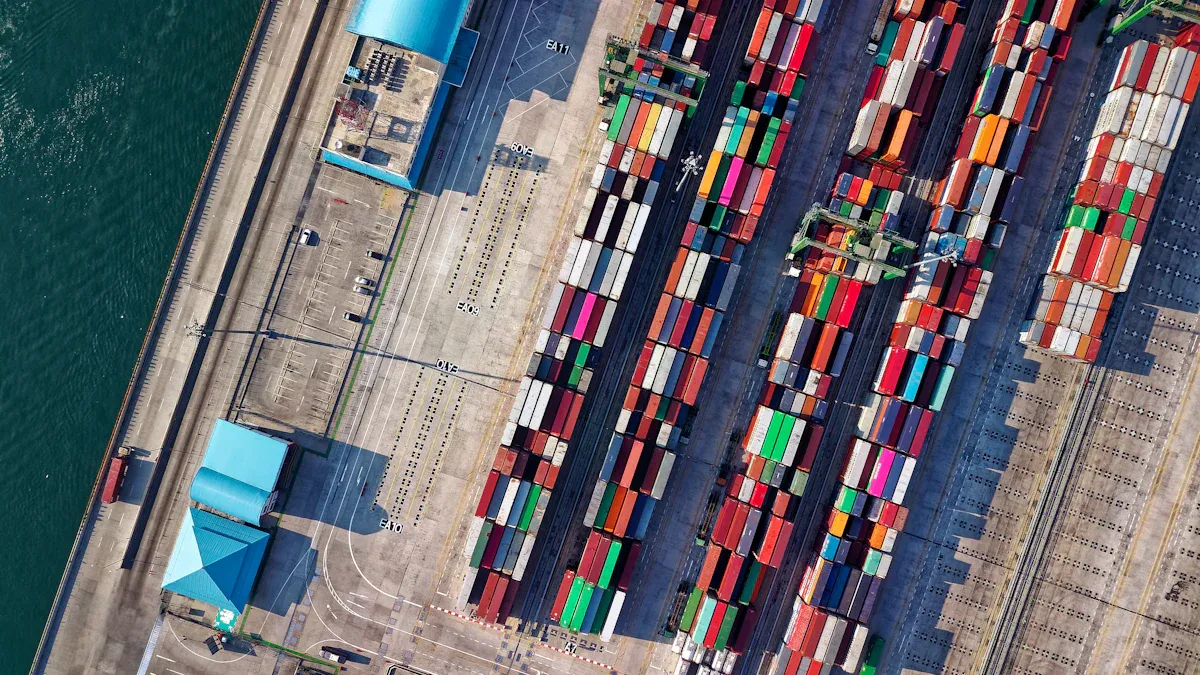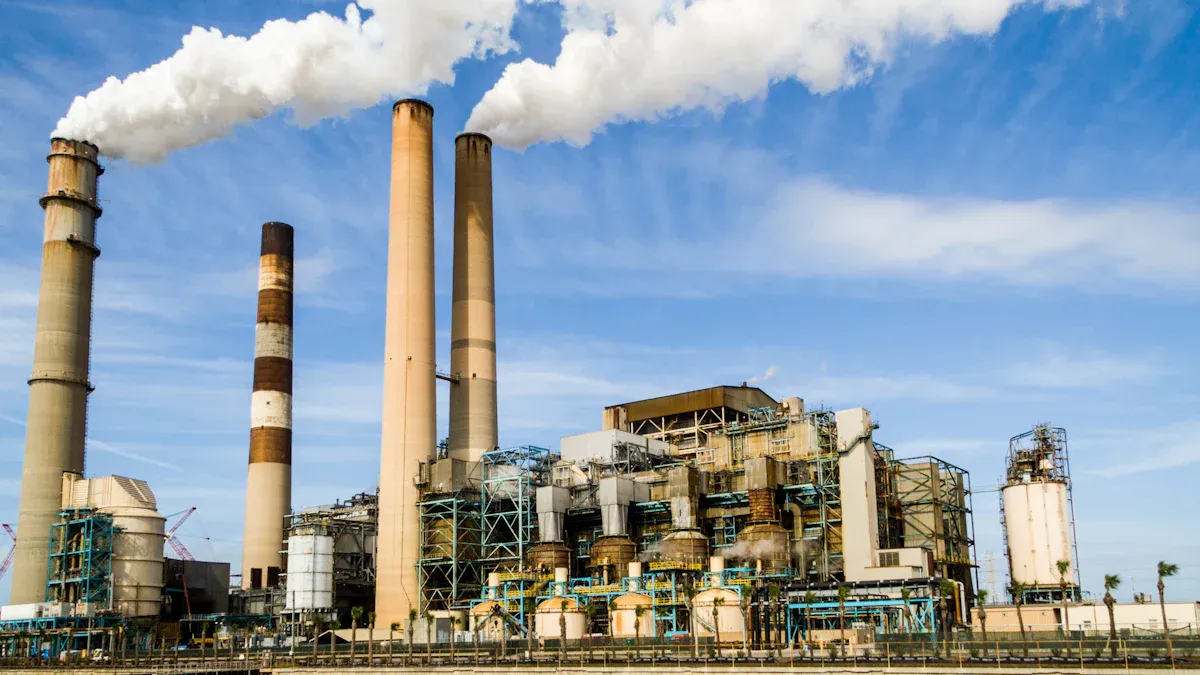China and US Manufacturing Supply Chains A Comparative Analysis

Understanding the dynamics of manufacturing supply chains in China and the United States is crucial for evaluating global economic trends. These two nations dominate the global manufacturing landscape, contributing nearly one-third of the world’s economic output. Over the past decade, China has expanded its global manufacturing share across key sectors, while the U.S. faced a notable shift in its manufacturing dynamics, commonly referred to as the "China shock." This comparative analysis helps businesses optimize their strategies and adapt to evolving supply chain realities. However, the environmental impact of these supply chains, particularly in China, remains a growing concern despite advancements in efficiency.
Key Takeaways
China's factories have grown a lot. Exports went from $14.3 billion in 1978 to $2.2 trillion in 2018. This growth happened because of smart changes and money from other countries.
The U.S. is still great at making high-tech products. It uses new ideas and advanced methods but faces problems like outsourcing and global competition.
Robots and AI are changing how factories work. They make things faster and cheaper. These tools also need workers who know programming and repairs.
Making things in eco-friendly ways is very important now. Companies that go green help the planet and get more loyal customers.
Countries like India and Vietnam are becoming important in global trade. They offer cheaper costs and good locations for businesses wanting to expand.
Historical Context of Manufacturing Supply Chains
Manufacturing Evolution in China
China's manufacturing journey has undergone a remarkable transformation over the past few decades. In 1978, the country exported goods worth $14.3 billion, with foreign direct investment (FDI) inflows at a modest $0.57 billion. By 2018, exports had skyrocketed to $2.2 trillion, and FDI inflows reached $137.3 billion, reflecting compound annual growth rates (CAGR) of 16.2% and 18.3%, respectively.
This growth stemmed from strategic reforms, including the establishment of Special Economic Zones (SEZs) and policies encouraging foreign investment. These measures enabled China to become a global manufacturing hub, producing everything from electronics to textiles. The country's focus on infrastructure development and workforce training further solidified its position in the global manufacturing supply chain.
Manufacturing Evolution in the US
The United States has long been a leader in manufacturing innovation. During the early 20th century, the introduction of assembly line production revolutionized industries, particularly in the automotive sector. By the mid-20th century, the U.S. had become a global manufacturing powerhouse, with intermediate inputs accounting for over half of the costs in most manufacturing sectors. For example, in the vehicles sector, intermediate inputs represent approximately 75% of gross output.
However, the late 20th century saw a shift as globalization encouraged companies to outsource production to lower-cost regions. Despite this, the U.S. remains a leader in high-tech manufacturing, with sectors like electronics relying heavily on intermediate goods, which account for about 25% of production costs.
Cost and Efficiency in Manufacturing Supply Chains
Labor Cost Comparison
Labor costs play a pivotal role in shaping manufacturing supply chains. In China, labor rates have doubled in recent years, reaching levels comparable to some European countries. Despite this increase, Chinese manufacturing wages remain significantly lower than those in the United States, where the gap persists. A comparative analysis reveals that Chinese manufacturing wages account for only 20% of U.S. wages, while India’s wages stand at a mere 3% of U.S. levels.
Country | Labor Cost Comparison |
|---|---|
China | Labor rates have doubled in recent years, now comparable to some European countries |
US | Manufacturing wages are significantly higher than in China, with a notable gap remaining |
Country | Manufacturing Wages as Percentage of US Wages |
|---|---|
China | 20% of US manufacturing wages |
India | 3% of US manufacturing wages |
These disparities influence global businesses when selecting manufacturing hubs. Lower labor costs in China attract companies seeking cost-effective production, while higher wages in the U.S. drive investments in automation and high-tech manufacturing to offset expenses.
Production Efficiency and Scalability
Production efficiency and scalability are critical factors in evaluating manufacturing supply chains. The United States excels in advanced techniques, leveraging regulations and cutting-edge technologies to enhance efficiency. For instance, U.S. models like GPT-4 demonstrate superior performance in logic, reasoning, and computation, supported by robust scalability frameworks. In contrast, Chinese models such as GLM-4 focus on semantic reasoning and scientific knowledge, benefiting from access to GPUs and vast data training.
Metric | U.S. Models (e.g., GPT-4) | Chinese Models (e.g., GLM-4) |
|---|---|---|
Benchmark | SuperGLUE | SuperCLUE |
Performance Focus | Logic, reasoning, computation | Semantic reasoning, scientific knowledge |
Scalability Factors | Advanced techniques, regulations | Access to GPUs, vast data training |
Future Projections | Continued improvement expected | Approaching competitive levels |
China’s scalability advantages stem from its ability to rapidly expand production capacity, supported by a large workforce and flexible infrastructure. However, the U.S. maintains a competitive edge in high-tech manufacturing, where precision and innovation drive efficiency.
Cost Implications for Global Businesses
Cost implications for global businesses extend beyond labor and production efficiency. The financial impact of low-cost suppliers can be significant, as disruptions in these supply chains often lead to substantial losses. A model developed by Simchi-Levi highlights this risk, showing that even a 2% disruption at low-cost suppliers can negatively affect profits. For example, Ford experienced considerable challenges due to supply chain disruptions, despite relying on less expensive components.
Companies must weigh the operational and financial risks associated with low-cost suppliers against the benefits of reduced expenses. Strategic decisions should prioritize resilience and adaptability to mitigate potential disruptions.
Global businesses increasingly recognize the importance of balancing cost savings with supply chain stability. Investments in diversified sourcing and advanced technologies help mitigate risks while optimizing manufacturing supply chains for long-term success.
Technology and Innovation in Manufacturing Supply Chains

Automation and Robotics Integration
Automation and robotics have revolutionized the manufacturing supply chain by enhancing efficiency and reducing operational costs. Robots operate continuously without breaks, minimizing downtime and accelerating production cycles. This capability allows manufacturers to meet tight deadlines and adapt to fluctuating demand. Additionally, automation reduces reliance on manual labor, enabling companies to allocate resources toward higher-value tasks.
Aspect | Impact |
|---|---|
Efficiency | Robots can work 24/7 without breaks, reducing downtime and speeding up production processes. |
Labor Costs | Robots enable a reduction in workforce size while increasing productivity and performance. |
Job Creation | Focus shifts to hiring skilled workers for programming and maintaining robots, creating higher-skilled jobs. |
The integration of robotics also fosters job creation in specialized fields. Companies increasingly seek skilled professionals to program, maintain, and optimize robotic systems. This shift not only improves productivity but also elevates the skill level of the workforce, contributing to long-term economic growth.
AI and Data-Driven Supply Chain Management
Artificial intelligence (AI) plays a transformative role in modernizing the manufacturing supply chain. By analyzing historical data and real-time inputs, AI enhances demand forecasting, enabling manufacturers to anticipate market trends and adjust production accordingly. This predictive capability minimizes overproduction and reduces waste, aligning with sustainability goals.
AI automates inventory management, providing real-time visibility and optimizing warehouse operations.
It improves resilience by predicting potential disruptions and assessing risks, enabling proactive contingency planning.
AI-driven systems streamline logistics, ensuring timely delivery and reducing transportation costs.
These advancements underscore the importance of data-driven decision-making in supply chain management. Companies leveraging AI gain a competitive edge by improving operational efficiency and responding swiftly to market changes.
R&D and Technological Advancements
Research and development (R&D) serve as the backbone of innovation in manufacturing supply chains. Investments in digital technologies enhance supply chain visibility, fostering innovation and competitiveness. For instance, AI applications in logistics, shipping, and inventory management have streamlined operations, reducing costs and improving efficiency.
A study by Augury revealed that 41% of respondents identified supply chain management as the primary application of AI in manufacturing.
The 2024 Material Handling Industry Annual Industry Report highlighted logistics and supplier selection as key areas benefiting from AI integration.
Government incentives promote the adoption of advanced technologies, particularly in critical minerals and green energy sectors.
These advancements reflect a commitment to technological progress. By prioritizing R&D, manufacturers can address challenges, adapt to evolving market demands, and maintain a robust manufacturing supply chain.
Labor and Workforce in Manufacturing Supply Chains
Labor Regulations and Worker Protections
Labor regulations and worker protections vary significantly between China and the United States. The International Labor Organization (ILO) reports that the Asia-Pacific region, including China, has the highest number of individuals in forced labor, with 28 million people affected. Complex supply chains in industries like technology often obscure unethical labor practices, leading to potential human rights violations.
In contrast, the United States enforces stricter labor laws, ensuring better worker protections. Regulations mandate fair wages, safe working conditions, and the right to unionize. These differences influence global perceptions of manufacturing supply chains, with companies increasingly prioritizing ethical sourcing to align with corporate social responsibility goals.
Workforce Availability and Demographics
China's manufacturing sector benefits from a vast labor pool. In 2009, the country employed 99 million people in manufacturing, a figure that has since grown to over 128 million, representing 16.9% of its workforce. This availability supports China's ability to scale production rapidly.
The United States, by comparison, employed only 14.2 million people in manufacturing in 2009, with the sector now accounting for approximately 10.5% of the workforce. While smaller in scale, the U.S. workforce focuses on high-tech manufacturing, leveraging advanced skills and innovation to maintain competitiveness. These demographic differences shape the strategies of global businesses when selecting manufacturing hubs.
Logistics and Proximity in Manufacturing Supply Chains

Geographical Advantages and Challenges
Geography plays a pivotal role in shaping the efficiency of manufacturing supply chains. Strategic location decisions can minimize transportation costs, reduce delivery lead times, and enhance overall operational efficiency. For instance, distribution centers located near major markets streamline logistics and improve customer satisfaction. However, these advantages come with challenges, such as the need for accurate demographic and transportation data to optimize planning.
Aspect | Advantages | Challenges |
|---|---|---|
Distribution Center | Minimizes transportation costs and reduces delivery lead times. | Requires accurate demographic and transportation data for effective planning. |
Route Optimization | Enhances efficiency by identifying the most efficient transportation routes. | Dependent on real-time data to adapt to changing traffic and road conditions. |
Market Segmentation | Tailors marketing strategies to specific regional markets. | Needs comprehensive understanding of regional consumer behavior. |
Risk Assessment | Identifies potential hazards and develops contingency plans. | Involves complex analysis of geopolitical and environmental factors. |
Manufacturers must weigh these factors carefully to ensure their supply chains remain resilient and cost-effective.
Proximity to Key Markets and Suppliers
Proximity to markets and suppliers directly impacts supply chain efficiency. A case study revealed that relocating a warehouse closer to suppliers and a major market in Texas reduced transportation time and costs. Companies that prioritize proximity to customers can enhance response times, build trust, and improve customer satisfaction.
Being near markets and suppliers streamlines operations and lowers transportation costs.
Research shows that proximity to suppliers can reduce transportation expenses by up to 20%.
Close access to customers enables faster delivery and strengthens brand loyalty.
These benefits highlight the importance of strategic location planning in optimizing the manufacturing supply chain.
Future Trends in Manufacturing Supply Chains
Shifts in Global Manufacturing Hubs
Advancements in manufacturing technologies, such as AI and robotics, are reshaping the global manufacturing landscape. These innovations are altering comparative advantages, particularly for developing nations that rely on low-skill labor. Automation reduces the need for manual tasks while increasing demand for skilled workers. Countries investing in technology and infrastructure, like Germany and South Korea, are emerging as leaders in this new era.
Reshoring production to advanced economies is another notable trend. Businesses prioritize proximity to consumers and access to skilled labor, which drives this shift. For example, the United States has seen a resurgence in domestic manufacturing due to these factors. This transformation underscores the importance of adapting to technological advancements to remain competitive in the manufacturing supply chain.
Sustainability and Green Manufacturing Practices
Sustainability is becoming a cornerstone of modern manufacturing. Companies are focusing on reducing environmental impact, conserving resources, and promoting ethical practices throughout their supply chains. Research shows that nearly 90% of a company’s carbon emissions originate from its supply chain, emphasizing the need for eco-friendly initiatives.
Green sourcing ensures raw materials are obtained responsibly.
Energy-efficient processes minimize resource consumption.
Waste reduction strategies lower environmental impact.
These practices not only benefit the planet but also enhance brand reputation and customer loyalty. As consumers demand greater accountability, businesses that adopt sustainable practices gain a competitive edge.
Emerging Markets and Their Role in Supply Chains
Emerging markets are playing an increasingly significant role in global supply chains. Countries like India, Vietnam, and Mexico are attracting attention due to their strategic advantages.
Country | Key Insights |
|---|---|
India | Growth driven by the Make in India initiative and improved logistics infrastructure. |
Vietnam | Low-cost manufacturing hub with a young workforce and strong infrastructure development. |
Mexico | Nearshoring trends benefit 16% of corporations, leveraging proximity to the U.S. market. |
A recent study revealed that 67% of global retailers and manufacturers have altered sourcing strategies due to disruptions. Many prioritize relocating supply chains closer to home, with emerging markets like Mexico and India poised to benefit. These shifts highlight the dynamic nature of the manufacturing supply chain and the growing importance of these regions.
China and the United States exhibit distinct strengths and challenges in their manufacturing supply chains. China benefits from lower labor costs and proximity to manufacturing hubs, while the U.S. excels in technological innovation and reliable infrastructure. Both nations invest heavily in automation, enhancing productivity and efficiency.
These differences shape global business strategies. Companies leverage lower production costs in China to remain competitive, while U.S. advancements in high-tech manufacturing attract industries requiring precision. Diversifying supply chains mitigates risks like disruptions and rising logistics costs, ensuring resilience and efficiency.
Adapting to future trends is essential for long-term success. Businesses must prioritize sustainability, enhance data management, and embrace automation to optimize processes. These strategies not only reduce environmental impact but also align with evolving consumer expectations and regulatory demands.
FAQ
Why is sustainability important in manufacturing supply chains?
Sustainability reduces environmental impact, conserves resources, and aligns with consumer expectations. Companies adopting green practices gain a competitive edge by improving brand reputation and meeting regulatory demands. Sustainable supply chains also minimize waste and promote ethical sourcing, benefiting both businesses and the planet.
How do labor costs influence global manufacturing decisions?
Lower labor costs in China attract companies seeking cost-effective production. In contrast, higher wages in the U.S. drive investments in automation and advanced manufacturing techniques. Businesses weigh these factors to balance cost savings with operational efficiency and supply chain resilience.
What role do emerging markets play in global supply chains?
Emerging markets like India, Vietnam, and Mexico offer cost advantages, strategic locations, and growing infrastructure. These regions attract businesses seeking to diversify supply chains and reduce risks. Nearshoring trends further enhance their appeal, especially for companies targeting proximity to key markets.
See Also
Enhancing Supply Chain Strategies for Advanced Manufacturing Challenges
Analyzing Jusda's Supply Chains in Response to Global Needs
Unveiling Robotics Innovations Transforming Supply Chain Dynamics
The Importance of Supply Chains in Global Trade Today
Mastering Lean Logistics for Success in High-Tech Manufacturing
